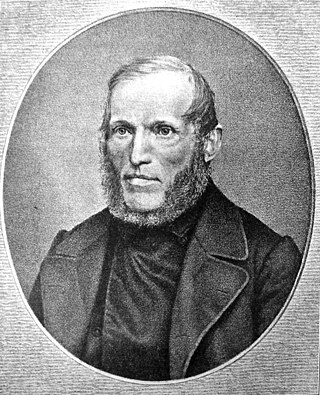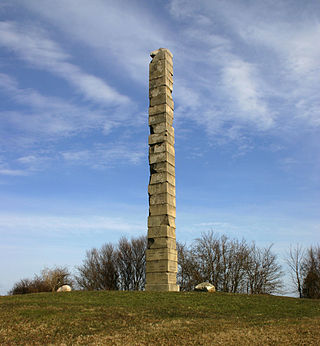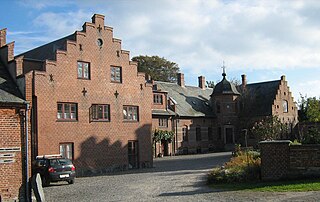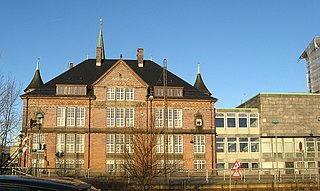
Præstø is a town with a population of 3,893 in Vordingborg Municipality in Region Sjælland on the east coast of the island of Zealand (Sjælland).

Jeppe Aakjær was a Danish poet and novelist, a member of the 'Jutland Movement' in Danish literature". A regionalist, much of his writings were about his native Jutland. He was known for writings that reflected his concern for the impoverished and for describing rural existence.

Nikolaj Frederik Severin Grundtvig, most often referred to as N. F. S. Grundtvig, was a Danish pastor, author, poet, philosopher, historian, teacher and politician. He was one of the most influential people in Danish history, as his philosophy gave rise to a new form of nationalism in the last half of the 19th century. It was steeped in the national literature and supported by deep spirituality.

Peter Vilhelm Carl Kyhn was a Danish landscape painter who belonged to the generation of national romantic painters immediately after the Danish Golden Age and before the Modern Breakthrough. Even though he outlived many of his artistic peers by several decades, he remained a traditionalist and expressed strong criticism of many of the new trends in the painting of his day.

Svend Hersleb Grundtvig was a Danish literary historian and ethnographer. He was one of the first systematic collectors of Danish traditional music, and he was especially interested in Danish folk songs. He began the large project of editing Danish ballads. He also co-edited Icelandic ballads. He was the son of N. F. S. Grundtvig.
Danmarks gamle Folkeviser is a collection of all known texts and recordings of the old Danish popular ballads. It drew both on early modern manuscripts, such as Karen Brahes Folio, and much more recent folk-song collecting activity.

Peder Vilhelm Jensen-Klint was a Danish architect, designer, painter and architectural theorist, best known for designing Grundtvig's Church in Copenhagen, generally considered to be one of the most important Danish architectural works of the time. Its Expressionist style relies heavily on Scandinavian brick Gothic traditions.

Christen Mikkelsen Kold was a Danish teacher, notable for creating the Danish Folk high school system, for non-degree education of adults.

Andreas Peter Berggreen was a Danish composer, organist, and pedagogue.

Skamlingsbanken is a large hill located in Vejstrup Parish, Jutland, Denmark, between Kolding and Christiansfeld. With a peak rising to 113 metres (371 ft) above sea level, it is the highest point in Southern Jutland.
Kristian Ostergaard was a Danish-American Lutheran pastor, educator, author and hymnwriter.

Rødkilde Højskole is a folk high school just south of Stege on the Danish island of Møn. Founded in 1866, it is one of the older folk high schools in Denmark. Renamed Teaterhøjskolen Rødkilde, it now offers both short and longer courses for those wishing to learn more about the theatre, especially those aspiring to become actors. The main building by Ludvig Fenger, the student wing and the octagonal assembly building were listed on the Danish registry of protected buildings and places by the Danish Heritage Agency on 8 July 1982.
Events from the year 1872 in Denmark.

Evald Tang Kristensen was a Danish folklore collector and author. Working first as a schoolteacher and later solely as a collector, he assembled and published a huge amount of detailed information on all aspects of folklore as he visited country people throughout his native Jutland.

Folk high schools are institutions for adult education that generally do not grant academic degrees, though certain courses might exist leading to that goal. They are most commonly found in Nordic countries and in Germany, Switzerland and Austria. The concept originally came from the Danish writer, poet, philosopher, and pastor N. F. S. Grundtvig (1783–1872). Grundtvig was inspired by the Marquis de Condorcet's Report on the General Organization of Public Instruction which was written in 1792 during the French Revolution. The revolution had a direct influence on popular education in France. In the United States, a Danish folk school, called Danebod, was founded in Tyler, Minnesota.

Aarhus Katedralskole is a cathedral school, an institution of secondary education, a Danish Gymnasium and a listed building in Aarhus, Denmark. The school is situated in the neighborhood Midtbyen, in the Latin Quarter, bounded by the streets Mejlgade, Kystvejen and Skolegyde. Aarhus Katedralskole offers the 3 year Matriculation examination (STX) programme with elective subjects in the natural sciences, social sciences and arts. The school is an independent self-owning institution financed by the Danish state with about 800 students divided across 30 classes.
Margrethe Sofie Charlotte Christiansen née Appel (1895–1971) was an influential Danish folk high school teacher who, together with her husband Carl Peder Ostenfeld Christiansen, taught for many years at Askov Højskole. In 1934, she and her husband were appointed leaders of Frederiksborg Højskole where she increasingly took over responsibilities for leadership until her husband's death in 1951. She later spent periods at Bordings Friskole and Snoghøj Højskolen. Active as a public speaker and writer, she is remembered for her biographies of her schoolteacher parents.

Haraldsgade is an approximately 1.1 km long street in the outer Nørrebro and Østerbro districts of Copenhagen, Denmark. It runs from Tagensvej in the southwest to Lyngbyvej in the northeast. Skjolds Plads Station, a station on the Copenhagen Metro City Circle Line, is located at the beginning of the street. The station takes its name after Skjolds Plads, a small square located off the east side of the street. The southwestern end of the street was closed to through traffic in connection with the opening of the metro station.

Askov Højskole is a Danish folk high school, that is located in the village of Askov in southern Jutland between Kolding and Esbjerg. It was founded in 1865 as an extension of Denmark's first folk high school, which had been established in 1844 in Rødding by Christian Flor. The first principal of Askov Højskole was Ludvig Schrøder.
Jens Kamp, born 11 February 1845 at Kamp-Hovedgård in Stadil parish in Jutland; died 23 May 1900 in Copenhagen, was a Danish folklorist.















